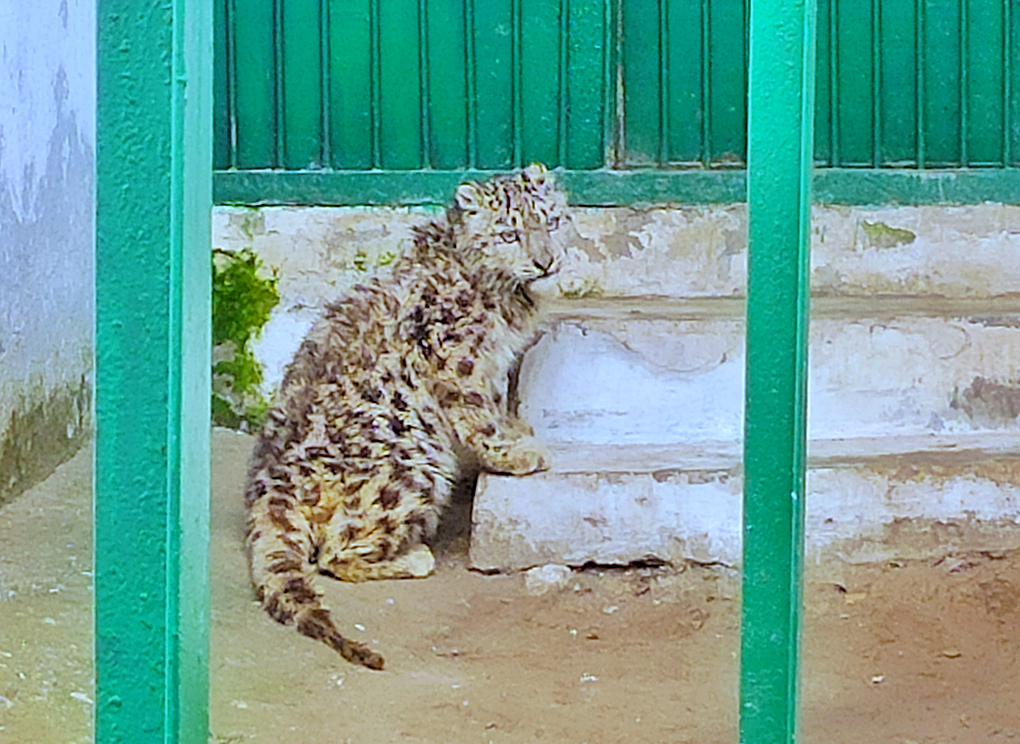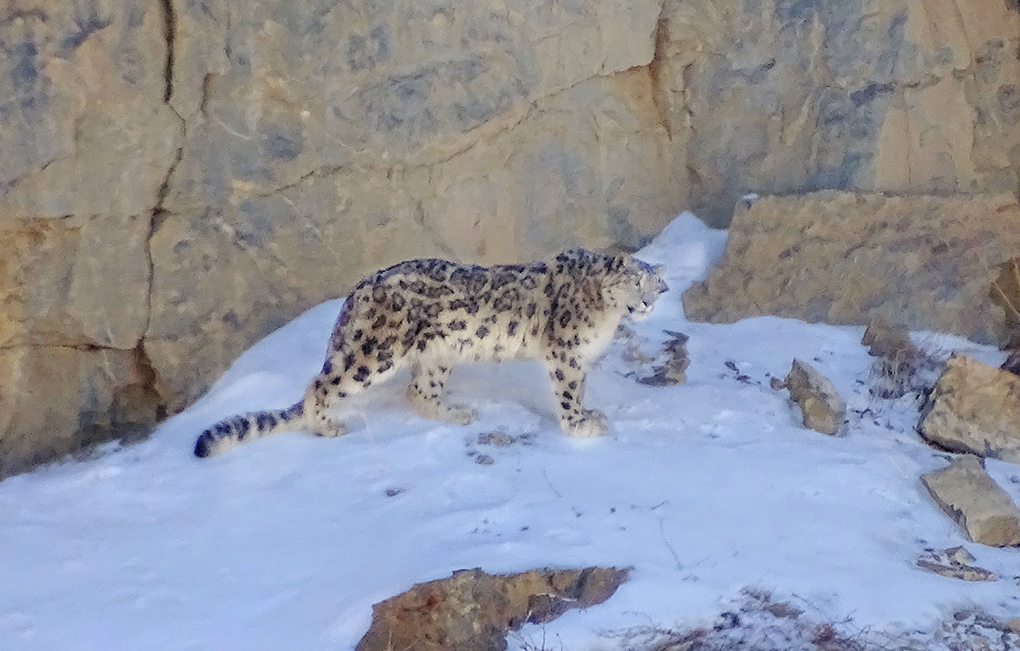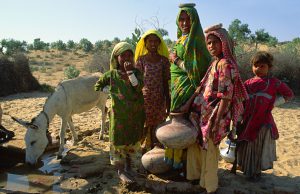High in the Himalayas near the India-China border, Gue is globally famous for the mummified remains of Buddhist monk Sangha Tenzin. It now has another reason for fame. In a rocky pasture near the Himachal Pradesh village located at a height of 3,200 metres, a snow leopard cub was rescued and returned to the wild.
In late April, 43 sheep and goats had been found dead in their pens within four days, incensing the residents of Gue, most of whom are shepherds. Responding to their demand, the state wildlife department installed a trap and a cage. On May 1, they found a snow leopard cub in the trap.
Eight months old and weighing just seven kilogrammes, the cub was wounded from trying to escape, weak, dehydrated and stressed. The tail had gangrene. Its teeth were milk teeth.
Gue is in the Spiti valley. From the valley’s main town Kaza, the cub was transported about 350 kilometres – a journey that takes around 10 hours – to the Himalayan Nature Park (HNP) in Kufri next to state capital Shimla. At 2,720 metres above sea level, Kufri is still at a significantly lower altitude than Gue, therefore far warmer than what snow leopards are used to. That was why the cub was moved at night, explained Sandeep Rattan, assistant director for veterinary services at HNP.
While at HNP, the cub developed two permanent teeth, the first sign of maturity, Savita, principal chief conservator of forests (wildlife) and chief wildlife warden of Himachal Pradesh, recounted joyfully.
Return to the wild
Savita told The Third Pole, “From the very beginning, when the veterinarian declared the snow leopard a cub, we decided to release it in its mother’s habitat.”
Ajay Bijoor, assistant director for the high-altitude conservation programme at Nature Conservation Foundation (NCF), said, “If the animal can be rehabilitated into the wild, it should be. That is the service we will do for the good of our own entire ecosystem. It is not ideal to make a wild-bred, healthy snow leopard suffer in the restricted environment of a zoo, fed by others and watched by tourists for fun.”
Under the guidelines of India’s Central Zoo Authority (CZA), if a rescued wild animal is not released within 30 days it has to be kept in a zoo.
Villagers and forest department staff near Gue had seen a female snow leopard in the area, and believed it to be the cub’s mother.
Once the cub had been treated for its injuries, on May 18, a joint HNP and NCF team took it back to the area where it had been trapped and released it.
“Our teams stayed in tents around the area for a couple of days even after animal’s release,” said Rattan. “We also conducting surveillance with camera traps. But the cub did not return after going inside the wood, which shows that it met its mother.”
Criticism and rebuttal
Some activists criticised the state wildlife department for separating the cub from its mother, keeping it in captivity for 16 days and then releasing it. They also said the department put the cub under severe stress by taking it on a gruelling journey twice, and moving it to a warmer climate.

Yash Veer Bhatnagar, a senior scientist at NCF who works on snow leopard conservation in India and Central Asia, said, “It seemed that the wildlife staff were not familiar with the young age of the animal at the time of rescue… The staff were also possibly put under severe pressure by local people, who were angry over killings of their livestock. However later it was found to be weighing just seven kilogrammes, exceptionally low for a cub, and may have needed external help to survive, which was facilitated at NHP.”
There were worries that the cub would not find its mother and would struggle to fend for itself – or that the mother would reject it. S. Sathyakumar, a scientist at the Wildlife Institute of India who studies snow leopards, said, “In carnivorous [cats] like snow leopards, tigers and leopards which are solitary animals, there is absolutely no such problem that the mother may not accept the cub, no matter how long the separation.”
“Animals communicate in a variety of ways, such as leaving their signs by marking their territory, leaving scat, making contact calls etc. Therefore the mother would have been able to track the young one through all these signs or vice-versa by now.”
Need for rescue facilities
Bhatnagar said female cubs live with their mother until the age of three years. Males leave to find their own territory when aged between one and one-and-a-half. The gender of this cub is still unclear.
Of an estimated 470 snow leopards in India, around 90 are in Himachal Pradesh, according to Sathyakumar. “A national-level protocol called the Snow Leopard Population Assessment in India was launched on October 23, International Snow Leopard Day, last year,” he said. “The work has been delayed because of Covid-19. Hopefully by next year we will mount camera traps to check the probability of occupancy. The result will be declared in 2022.” Sathyakumar is heading the project.
There have been a number of incidents involving sick or injured snow leopards in Himachal Pradesh in recent years.
On February 5 this year a snow leopard cub was rescued in Manali by the Border Roads Organisation, which develops and maintains road networks in India’s border areas. It was handed over to the forest range officer, but died. In March, an adult snow leopard was found dead; there is speculation it had fallen from a height. In 2017 a 13-year-old snow leopard died in the village of Kibber in Spiti Valley. It was fed by local villagers for a few days but did not survive.
Sathyakumar said small rescue facilities need to be established in the districts of Lahaul and Spiti under the CZA’s guidelines. This would keep snow leopards in their natural climate and mean faster treatment.
Human-animal conflict
Snow leopards, categorised as vulnerable in the International Union for Conservation of Nature’s Red List of Threatened Species, are the top predators in the world’s toughest terrain, but are also known to steal into sheep pens for an easy meal. It does not make them the favourite of shepherds. In recent years, conservationists have tried to solve this problem by distributing strong fencing to place around sheep pens. Clearly, more fences are needed if locals are to support protection of the endangered big cat.
See: Saving the elusive snow leopard
There is also a community insurance scheme to compensate shepherds for livestock lost due to predation. Hardev Negi, divisional forest officer for Kaza, said that the villagers would receive INR 3,000 (USD 40) for each animal killed. NCF’s Bijoor explained, “The villagers fix an annual premium based on the category of animals they have. NCF contributes the same premium amount for the first five years … The introduction of the scheme was aimed at instilling a sense of ownership among villagers that they must feel that the snow leopard is their animal, and not the government’s.”

Abhishek Ghoshal, a wildlife biologist associated with the NCF, the Snow Leopard Trust and the WII, said that the sight of a snow leopard would create chaos among the livestock. The fear and confusion would also make the predator behave strangely, and it would start scratching and jumping over the animals. The livestock would likely have died from a combination of shock and exhaustion, he said.
The sheep-killing came to a sudden halt after the cub was trapped. NCF’s Bijoor told The Third Pole, “There is a possibility that the predator got wary after the cub’s rescue or the villagers themselves became vigilant in maintaining safety for their livestock.”
Savita said, “We have planned to provide a few sample predator-proof corrals, covered with iron mesh on all sides, to locals in the villages falling under snow leopard habitat.”
See: Living with the snow leopard
Last year a study on this issue in Ladakh was published by Tsewang Namgail, director and senior scientist at the Snow Leopard Conservancy India Trust, together with researchers from Panthera, the wild cat conservation organisation in New York. It revealed that predator-proofing corrals has resulted in a decline in the number of livestock killed by snow leopards in recent years. It can also help locals.
See: Snow leopards bring education to Basha valley girls
A relatively new problem being faced by snow leopards is the number of tourists who want to see them. Ghoshal said the animal is disturbed in the name of tourism. “People don’t know what they are doing by causing excessive noise, disturbance and littering in the higher Himalayan landscape of the snow leopard. Snow leopards are highly elusive animals, but during the breeding season they make repeated calls for mating and are likely to be present at one site for three to four days. This makes them susceptible to sightings by human. Imagine a group of 50-odd people creating visual disturbance to the animal during the breeding season. This may badly impact their breeding.”


![There could be more muddy rain in the future, scientists say, as climate change makes wind patterns more erratic and unpredictable [Kathmandu image by: Alamy]](https://dialogue.earth/content/uploads/2020/06/Kathmandu-300x200.jpg)





![Flooding of the River Bagmati, a tributary of the Ganga, in Bihar [image by: Joerg Boethling/Alamy]](https://dialogue.earth/content/uploads/2020/06/Bihar-floods-Bagmati-Joerg-Boethling-Alamy-Stock-Photo-300x194.jpg)
